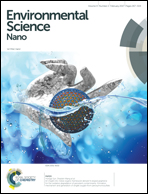Dependence of the irradiation conditions and crystalline phases of TiO2 nanoparticles on their toxicity to Daphnia magna†
Abstract
The widespread proliferation of titanium dioxide (TiO2) and its inevitable release into aquatic environments have led to growing concerns about its hazards to the environment. However, knowledge regarding the influence of irradiation and crystalline phases of TiO2 nanoparticles (NPs) on their mechanisms of toxicity is lacking. This study systematically evaluated the toxicity of five types of TiO2 NPs with varying percentages of their crystalline forms under three different irradiation conditions. The 50% effective concentrations (EC50) of all the anatase/rutile mixtures illuminated with ultraviolet (UV) light were lower than those of their counterparts under visible light or in the dark. Among the mixtures, the 4 : 1 anatase/rutile mixture yielded the lowest EC50 of 3.58 mg L−1 under UV illumination, likely due to the higher level of bioaccumulation and oxidative stress, as quantified by reactive oxygen species (ROS) and superoxide dismutase enzyme (SOD). TiO2 NPs under UV illumination showed higher photocatalytic activity towards ROS production due to the stronger absorption in the corresponding wavelengths, leading to higher oxidative stress. The anatase/rutile mixture in a ratio of 4 : 1 displayed an appropriate band gap to generate excitons related to oxidative stress, which induced high toxicity. Our study suggested that the oxidative stress-related toxicity of TiO2 NPs to daphnids may be significantly related to the band gap of exciton generation.



 Please wait while we load your content...
Please wait while we load your content...